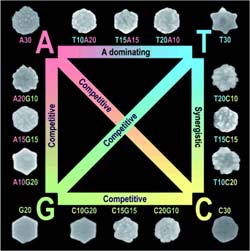Gold Nanoparticles Follow “Genetic Code”

<br>
Gold is not just the material of choice for pretty jewelry; it is also used in technology, for example in nanoscopic particles for applications such as catalysis, biomedicine, and sensors. In the journal Angewandte Chemie, a team of American and Chinese researchers has now demonstrated that the morphology of gold nanoparticles can be controlled when they are synthesized in the presence of DNA. Depending on the DNA sequence used, the shape and surface roughness can be varied.
Because of its defined structure, DNA is often used as a “template” or “scaffold” for the production of nano-objects and nanomaterials. A team led by Yi Lu from the University of Illinois at Urbana-Champaign (USA) and Jinghong Li from the Tsinghua University Beijing (China) have now used gold nanoparticles to demonstrate that DNA can influence the morphology of nanomaterials as well as their structure and functionality.
In order to produce gold nanoparticles, the researchers use a solution of a gold salt to which they add a mild reducing agent and tiny prismatic gold seed crystals. The reducing agent reduces the gold ions of the salt to elemental gold, which is deposited onto the seed crystals. In the presence of short DNA strands, these crystallize further to form larger, defined nanoparticles. In the absence of DNA they form significantly larger, irregularly shaped agglomerates instead.
Interestingly, the length of the DNA strands is irrelevant whereas the identity of the bases (adenine, cytosine, guanine, and thymine) in them is not. If the researchers add DNA that only contains guanine, the resulting nanoparticles are flat hexagons; DNA made of pure thymine produces tiny six-pointed stars with a smooth surface; pure adenine leads to the formation of rounded, rough particles; and cytosine generates round, flat platelets. In each case the particles are of uniform size and shape.
The scientists also tested DNA strands made from two different bases. In most cases the base that is present in larger amounts dominates. However, the combination of thymine and cytosine is interesting. These two bases apparently work synergistically because together they produce a new form: flower-like nanoparticles that are thinner in the middle and thicker at the edges. Increasing the proportion of thymine makes the edges thicker.
“Our work could provide a new method for synthesizing nanoparticles with predictable structures with fine-tuned morphologies for widespread applications,” says Lu. “Nanoparticles with complex shapes and rough surfaces have recently been shown to have enhanced performance as catalytic components and support materials for analytical processes like Surface-Enhanced Raman Spectroscopy. They are also better absorbed by cells.”
About the Author
Dr. Yi Lu is Jay and Ann Schenck Professor of Chemistry at the University of Illinois at Urbana-Champaign. His group is interested in design and directed evolution of novel biocatalysts, biomaterials, and biosensors, including their applications in renewable energy generation, environmental monitoring, medical diagnostics, and targeted drug delivery.
Author: Yi Lu, University of Illinois at Urbana–Champaign (USA), http://www.chemistry.illinois.edu/faculty/Yi_Lu.html
Title: Discovery of the DNA “Genetic Code” for Abiological Gold Nanoparticle Morphologies
Angewandte Chemie International Edition, Permalink to the article: http://dx.doi.org/10.1002/anie.201203716
Media Contact
More Information:
http://pressroom.angewandte.orgAll latest news from the category: Life Sciences and Chemistry
Articles and reports from the Life Sciences and chemistry area deal with applied and basic research into modern biology, chemistry and human medicine.
Valuable information can be found on a range of life sciences fields including bacteriology, biochemistry, bionics, bioinformatics, biophysics, biotechnology, genetics, geobotany, human biology, marine biology, microbiology, molecular biology, cellular biology, zoology, bioinorganic chemistry, microchemistry and environmental chemistry.
Newest articles

Properties of new materials for microchips
… can now be measured well. Reseachers of Delft University of Technology demonstrated measuring performance properties of ultrathin silicon membranes. Making ever smaller and more powerful chips requires new ultrathin…

Floating solar’s potential
… to support sustainable development by addressing climate, water, and energy goals holistically. A new study published this week in Nature Energy raises the potential for floating solar photovoltaics (FPV)…

Skyrmions move at record speeds
… a step towards the computing of the future. An international research team led by scientists from the CNRS1 has discovered that the magnetic nanobubbles2 known as skyrmions can be…





















